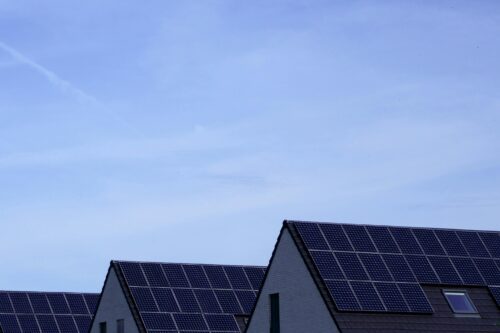
Collaborative Efficiency: Unlocking the Full Value of Public Energy Programs
This blog post explores how better coordination and data sharing across California’s energy programs can boost impact, reduce costs, and better serve communities.
Collaborative Efficiency: Unlocking the Full Value of Public Energy Programs
By Erik Hagstrom and Phoebe Skok
In California, ratepayers fund a broad portfolio of energy programs through the Public Goods surcharge that’s overseen by the California Public Utilities Commission (CPUC). This surcharge supports initiatives run by Investor-Owned Utilities (IOUs), Community Choice Aggregators (CCAs), Regional Energy Networks (RENs), and nonprofits to deliver benefits including energy efficiency upgrades, electrification incentives, renewable technology research, and targeted support for low-income households.
Yet, despite significant investment into energy efficiency programs in California — $4.3 billion was approved for 2024–2027 — the state has struggled to meet its ambitious goals. From 2016 to 2022, electric efficiency programs fell short of targets by 1,400 GWh, enough to power 230,000 homes annually (California State Auditor). This is addressed by empowering local administrators to conduct better lead and data sharing, and design programs that meet unique local needs.
The Cost of Silos
As electricity rates climb, so does scrutiny of these programs’ funding. While cutting program funding could lower rates, such cuts would undermine essential services, especially for underserved communities who benefit most from clean energy investments. Rather than delivering improvements by reduction in funding through the gutting of critical programs, improved program structure can yield increased results without additional program funding. To understand why these investments on behalf of ratepayers fall short, it’s important to examine how the programs themselves are coordinated.
A core issue is a lack of integration by program administrators. Many programs target similar goals like energy efficiency, electrification, or renewable adoption, and often serve overlapping populations. However, program administrators typically operate in silos. For instance, a customer completing a PG&E program is rarely made aware of complementary offerings from MCE or BayREN, even when eligibility and benefits align.
This siloed approach leads to duplicated marketing, wasted ratepayer dollars, and missed opportunities for deeper impact. Each new customer or project lead can cost program administrators and thereby ratepayers thousands in outreach, with costs increasing as ‘low hanging fruit’ are exhausted. If leads and project data were shared across program administrators, customers could seamlessly access the full suite of available programs; maximizing the impact of dollars spent.
The solution to this lack of integration is not the consolidation of program administration at the state or IOU level. Doing so has yielded negative outcomes (Self Generation Incentive Program) and leaves programs unable to adapt to local needs. Local administrators, who work and serve cities, counties and regions can identify gaps in service and provide tailored programs and outreach. Mailers may work in one community while outreach through religious institutions is key in another. Additionally, administering programs at the state level does not allow for programs to be designed to synergize with local initiatives. Regions dealing with air pollution or regular blackouts should be given the flexibility to tailor programs towards intersecting solutions, such as the promotion of EVs or resilience solutions respectively.
Progress and Challenges in Data Sharing
Still, data sharing between public energy programs has improved in recent years. For example, Marin Clean Energy (MCE) has developed an internal Customer Relationship Management (CRM) system that tracks customer usage data and recommends relevant programs, such as linking EV rebate recipients to EV charging incentives or discounted charger programs. MCE’s system enables cross-qualification and referral; customers can also opt-in to have their information shared with MCE’s external partners like BayREN to access more programs.
BayREN and other RENs are also pushing for broader access to customer data, aiming to replicate MCE’s integrated approach. Organizations are now communicating more than ever and automatically referring customers to the best-fit program administrator. However, most data-sharing still depends on explicit customer opt-in, leaving significant information gaps, especially for programs not governed by the CPUC’s Energy Efficiency (EE) proceeding.
Joint Cooperation Memos: A Tool for Collaboration
To address these gaps, the CPUC has required Joint Cooperation Memos (JCMs) among program administrators under the EE proceeding. JCMs formalize collaboration and enable data sharing, coordinated outreach, and joint planning to avoid duplicative efforts and ensure broader program reach.
Their key features include:
- Formalized Data Sharing: JCMs allow administrators to share program participation and completion data, subject to privacy protections.
- Coordinated Outreach: Administrators plan outreach to avoid targeting the same communities with overlapping programs.
- Lead Generation and Project Sharing: JCMs facilitate sharing of project leads and customer referrals, increasing multi-program participation.
However, JCMs have limitations. They are typically open-ended and challenging to amend, which can dilute their effectiveness over time. JCMs are also restricted to programs under the EE proceeding, leaving gaps for other demand-side management (DSM) initiatives — such as demand response or distributed energy resources — which will require new frameworks for integration.
Policy Recommendations: Toward a Collaborative Efficiency Framework
To unlock the full value of public energy investments, California should build on the foundation of JCMs and recent data-sharing progress to move toward a more integrated, customer-centric approach.
We recommend the following:
1. Require Opt-Out Data Sharing Across All Administrators
- Make opt-out data-sharing a condition of program funding for all administrators (IOUs, CCAs, RENs).Doing so would reduce duplicated outreach costs and ensure customers are seamlessly connected to all eligible programs, not just those they initially enroll in.
2. Expand and Update Joint Cooperation Memos
- Encourage all administrators in overlapping service territories to form regional task forces, identify 5–10 high-synergy program pairs (e.g., electrification rebates + time-of-use rates), and pilot integrated outreach and enrollment. Allowing for periodic amendments to include new programs and demand-side management initiatives, would ensure that JCMs remain relevant and flexible as the program landscape evolves.
3. Leverage Local Program Administration
- Deployment of this strategy requires local administrators (e.g., RENs, CCAs) to innovate in data sharing and customer engagement, using tools like MCE’s CRM as a model. Local programs are often best positioned to identify community needs and facilitate cross-program participation.
4. Require Annual Reporting on Collaboration Outcomes
- Metrics:
- Reduction in customer acquisition costs
- Increase in multi-program participation rates (target: 25% by 2030)
- Energy savings from synergistic projects (e.g., electrification + solar)
By moving from fragmented, siloed administration to a locally collaborative, data-driven approach, California can maximize the impact of its $4.3 billion clean energy investment. Leveraging tools like JCMs, expanding data sharing, and empowering local administrators will ensure that every ratepayer dollar delivers measurable benefits: especially for underserved communities. The result? A more effective, equitable, and resilient energy transition for all Californians.
 Phoebe Skok
Phoebe Skok
Phoebe is a freelance journalist, science writer, and communications professional with a master’s degree in climate science and policy from Scripps Institution of Oceanography. Based in the Seattle area, Phoebe primarily covers clean energy technology, markets, and policy for outlets like pv magazine USA, ESS News, and Latitude Media. She’s also a certified LEED Green Associate and budding travel writer. Outside of work, Phoebe spends as much time as possible exploring the world, and loves jumping into cold water, testing new vegan or gluten-free recipes, and doing the New York Times crossword.

